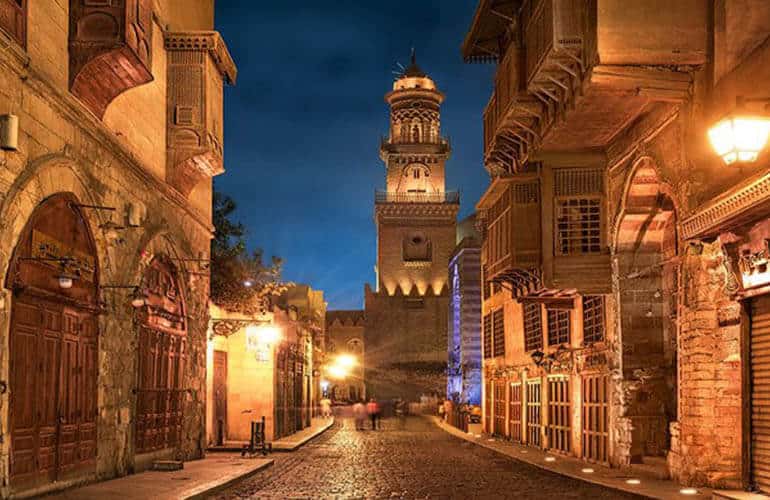Cultural, historical, adventure, and custom customized trips are just a few of the tours that Deluxe trips offer in Egypt and Jordan.

Step into the heart of Islamic Cairo, where time seems to have stopped and every stone whispers a secret. Al Moez Street, which commemorates the name of Fatimid Caliph Al-Mu'izz li-Din Allah, is not a street; it's a vibrant open-air museum that showcases over 1,000 years of Islamic architecture, culture, and heritage. For travelers looking for a true glimpse of Egypt's great Islamic legacy, Al Moez Street is a must-visit destination.
Al Moez Street, which was originally founded in the 10th century during the Fatimid period, passes through the center of Islamic Cairo from Bab Al-Futuh and Bab Al-Nasr in the north down to Bab Zuweila in the south.
The street was at the heart of Cairo's urban and religious life and was the main artery of commerce and administration. Over the centuries, the quarter housed mosques, madrasas (Islamic schools), sabils (public water fountains), hammams (baths), and khanqahs (Sufi lodges).
Today, after immense renovation efforts by the Egyptian government and UNESCO, a significant number of these monuments have been restored to their former glory.
Built in the 10th century under the Fatimid regime, this is Cairo's oldest and largest mosque. It boasts beautiful minarets and a serene courtyard perfect for reflection.
A true masterpiece of Mamluk architecture, the Qalawun Complex boasts a mosque, madrasa, hospital, and mausoleum—all constructed at Sultan Al-Nasir Muhammad's request in the 13th century.
This Ottoman-period building is the only one that combines a public water fountain (sabil) with a children's school (kuttab) for memorization of the Quran. It is one of the finest preserved of its type.
This 17th-century Islamic traditional house gives a special glimpse of the everyday life of a successful Cairene family. The layout, inner courtyard, mashrabiya screens, and furnishings show the social customs of the time.
The south gate of the ancient city wall offers theatrical views over Cairo. It is one of the remaining gates and is deeply associated with the medieval military history of the city.
Al Moez Street is architecturally significant, sure, but it's also a busy hub of Egyptian Islamic culture. The muezzin's voice calls out across the air, the smell of freshly baked bread fills the street stalls, and traditional craftsmen still ply their trade in narrow alleys. Locals and tourists alike sit and sip mint tea in quaint cafes, basking in ageless atmosphere.
Al Moez Street, during Ramadan, is a street of light, lanterns, and collective bliss. It's a hit spot for iftar, prayer nights, and strolls in the evening.
Best Time to Visit: Early morning or late afternoon, especially during spring and autumn when weather conditions are perfect.
What to Wear: Uncomplicated, comfortable clothing, especially when visiting religious buildings.
Local Guides: Having a local guide or certified Egyptologist as a hire enhances the experience by giving meaning to finer details that might otherwise be overlooked.
If you are exploring Cairo day tours, don't miss Al Moez Street. It's an excellent addition to your itinerary along with the Egyptian Museum, Saladin Citadel, and Khan El Khalili Bazaar. The street offers an experience that harmoniously combines Cairo's religious, architectural, and social heritage.
From its majestic Islamic landmarks to the lively street scenes and spiritual ambiance, Al Moez Street is a captivating journey through Egypt’s Islamic heritage. Whether you’re a history buff, a cultural explorer, or simply a curious traveler, walking through Al Moez is like flipping through the pages of a living history book.
Discover now our answers to the most common questions that may come to your mind about tourism and trips to Egypt
Cultural, historical, adventure, and custom customized trips are just a few of the tours that Deluxe trips offer in Egypt and Jordan.
The Dead Sea, Petra in Jordan, the Pyramids of Giza, Luxor's historic temples, and many other famous sites can be expected to be explored with Deluxe Tours.
offer a hassle-free holiday, Deluxe Tours' packages generally include lodging, transport, meals, guided tours with experienced local experts, and entry fees to attractions.
Spring (March to May) and fall (September to November) offer the finest weather for sightseeing and outdoor activities, making those months the best times to visit Egypt and Jordan.
These two countries are close by, only a 1.5-hour flight apart, and when combined, offer a variety of distinctive experiences. We advise you to spend at least 12 days visiting both countries for a truly unforgettable experience
Combining the eclipse viewing with visits to historic sites like the Pyramids of Giza, the Valley of the Kings, and a Nile River cruise are highly recommended.
